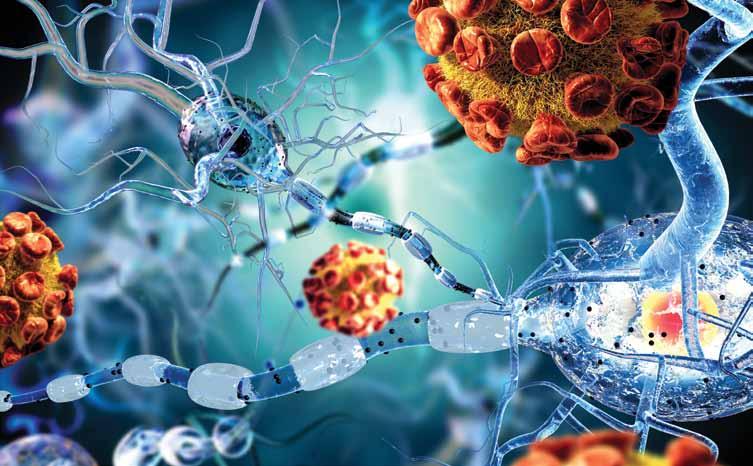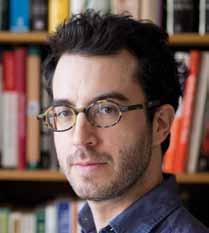
10 minute read
NORTH TEXAS
If people can’t do everything that needs to be done, what small steps can they take that will have a collective impact?
We all need to question what our own limits are, what we can do and then do that with rigor. We don’t need to stop flying, we just need to do it a lot less. I wouldn’t encourage anyone to suddenly become vegan. I think a better idea is to eat as few animal products as possible, and if that amount is zero, great. If it’s once a week or once a day, then that’s a hell of a lot better than doing nothing. Rather than measuring the distance from some ethical perfection, we want to measure the distance from doing nothing at all.
Advertisement
Why is it such a struggle for people to follow through on climate change goals?
I think that if we approach change as if it isn’t difficult, then we diminish our chances of being able to sustain change. A lot of the things we need to give up are fun. It’s a shame we can’t solve climate change by not eating broccoli; we would have done it already.
Climate change requires a different sort of moral imagination because, realistically, you and I aren’t going to die because of it. Human nature makes it more difficult to have an energetic response for something less immediate.
What call to action would you like to convey?
We have a feeling of helplessness, a feeling that there’s nothing we can do, but there is a lot that we can do and must do. The easiest and most powerful way to begin is with what we eat. That doesn’t mean you become vegan tomorrow, but tomorrow is a wonderful time to start eating fewer animal products. It’s a journey, not an event.
Julie Peterson writes about health and the environment. Connect at JuliePeterson2222@gmail.com.
North Texas Plant-Based Nutrition Leaders Sound Off
Nutrition professionals have the education and experience to advise clients on many aspects of general health and disease prevention in particular. Here, some of our local experts express their firsthand experiences in their own words, along with advice and wisdom for us all.
Patricia Thomson says, “At the age of 59, my dad underwent a quadruple bypass. Eleven years later, he would succumb to heart disease, leaving a wake of grief behind. Around the time of his death or shortly thereafter during an annual medical exam, my doctor diagnosed me with high cholesterol. They convinced me that I was following in my father’s footsteps and that I was destined by my genetics to have heart disease. At 41, I was fairly active, ate what I thought was a very healthy diet, consumed very little fast food and included fruits and vegetables in my food choices. I walked out of there stunned. I went on cholesterollowering medicine and went on my way until I came across a radio broadcast by a doctor talking about how food can determine your susceptibility to lifestyle diseases such as heart disease, diabetes, obesity, autoimmune disease and even cancer. The bottom line was that a whole food, plant-based diet could help prevent and reverse most lifestyle related diseases, and that we did not have to be victims of our genetics.
“Fast forward 10 years later, and I have lost weight and gained wonderful health. I admit I do spend more time in the kitchen cooking, but I have learned fast and easy ways to prepare healthy and delicious foods. I do meal preps so that I have meals in the refrigerator and freezer at all times. I have saved money eating this way since I am not buying expensive meats, cheeses, processed foods and fast foods. I created TS Wellness and have now dedicated my life to helping others transition to a healthier way of eating and living their lives. I conduct cooking and nutrition classes and created the Food as Medicine Summit & EXPO as a way to bring the experts together to share this information with the general public.”
Patricia R. Thomson, Ph.D., is the founder and president of TS Wellness and the Food as Medicine Summit & Expo, held Aug. 28 and 29 at the Richardson Civic Center. For more information visit TSWellness.com and FoodAsMedicineSummittTX.com.
Brooke Ali states, “Friends invited me to an event at a mansion in Beverly Hills. The last thing I expected was to be sitting on a beautifully manicured lawn listening to testimonials from people from a food bank that participated in a documentary about going plantPatricia Thomson Brooke Ali
based. One after another, these participants shared how they lost eight to 32 pounds over the course of two months. They went off of their medication for high blood pressure, high cholesterol, depression and Type 2 diabetes. I was in awe. I had no idea that food could actually be healing. Nor did I know that the standard American diet was the main source of typical diseases we suffer from in the West. How did I not know about this magic? It has been 11 years, and the only thing I wish was that I learned about this well-kept secret sooner. I also vowed to help people eat more plant based if they asked.
“Here’s my advice on transitioning into a plant based lifestyle: take it at your own pace and take it as far as you feel comfortable; go cold to-furkey or gradually reduce the amount of dairy and animal products you consume; start with breakfast until you are comfortable and move on from there—for example, replace the milk in your cereal with oat milk or any plant based milk you prefer—other ideas for breakfast could be avocado toast, a smoothie, tofu scramble or oatmeal—once you are comfortable with breakfast, move to lunch, then dinner; watch documentaries such as What the Health, Forks Over Knives, Cowspiracy and Game Changers to help you to transition; and Google any recipe you want to make by just adding vegan
Brooke Ali is founder and co-owner of Viridescent Kitchen, in Plano. For more information, visit ViridescentKitchen.com.
Katherine Lawrence shares, “I grew up Cajun—delicious food, but not synonymous with healthy. I ate this way growing up, through my time in the military, and it eventually caught up to me in my late 20s. At 27 years old, I was diagnosed with Stage 4 endometriosis, ovarian cysts and complete infertility. At the time, I had excess body weight, high cholesterol and very little understanding of the connection between my food and my health. I was told I needed a full hysterectomy, because I was too high-risk for endometrial cancer, and that I would never have children! Rather than take such an aggressive approach, I began working with a nutritionist. She helped me change Katherine Lawrence
my diet, my cookware and my life. I remember her telling me I needed to remove meat and dairy from my diet and my first thought was, ‘Umm… all that’s left is sugar!’
“With her help, I transitioned to a whole food, plant-based diet (WFPB) and my life was forever changed. It took about six months, but we reversed all of my reproductive issues. I also lost 55 pounds, reduced my cholesterol naturally and experienced many other benefits along the way. Eventually, I went on to have three healthy boys! They are a daily reminder of the importance of our food choices and the power we have over our health. Since healing, I’ve gone to school for nutrition and taught over 8,000. In that experience, I’ve concluded that there are two necessities for an effective transition to WFPB. The first, is we must have a ‘why’; a compelling reason to change your diet, whether it is to reverse disease, prevent disease, reduce your carbon footprint, protect animals, etc. The second necessity is to find recipes that you truly enjoy eating. These two things will sustain you on this journey. Plug in, find a community, experiment in the kitchen, educate yourself and reap the many benefits that come along with this way of eating!”
Katherine Lawrence is the owner of Food Saved Me online Nutrition & Cooking Classes. She specializes in disease prevention and reversal through food and has been empowering people for more than 12 years. For more information visit FoodSavedMe.com.

Eye Care for Kids A Clear Path to Healthy Vision
The blurry distant vision of myopia is a worldwide epidemic. Nearsightedness has doubled in the U.S. since 1971 to 42 percent, and in some Asian countries it affects 90 percent of teens and adults, reports the American Academy of Ophthalmology. Eye doctors say the key time to pay attention is during childhood, because myopia and other eye and vision problems can be reversed or stabilized if addressed at an early age.
“Parents tend to assume that vision problems aren’t a concern for the young and healthy, but it’s never too early to promote healthful habits or to be on the lookout for potential vision issues,” advises ophthalmologist Sandy T. Feldman, M.D., medical director of the Clearview Eye & Laser Medical Center, in San Diego.
Ophthalmologists and optometrists recommend having a child’s eyes tested at 6 months, 3 years and 5 or 6 years to detect nearsightedness, farsightedness, astigmatism, “lazy eye” (amblyopia), crossed or misaligned eyes (strabismus) and other potential problems. “For signs of trouble, I ask parents if they have seen their child have an eye that wanders or if the child covers an eye regularly, they are rubbing their eyes or playing with their by Ronica A. O’Hara toys close to their face,” says optometrist Nathan Langemo, of the Hopkins Eye Clinic, in Hopkins, Minnesota.
If myopia becomes severe, it can lead to retinal detachment, premature cataracts and glaucoma in adulthood, but early detection is possible. An Ohio State University study of 4,500 children found that myopia in eighth-graders could be predicted in the first grade by their eyeglass prescription. Children at age 6 are naturally slightly farsighted, and those with normal vision are more likely to become myopic later.
A common medical treatment to slow myopia in kids is daily use of 0.01 percent atropine eye drops, the medication used to dilate an eye before an exam. It slowed down nearsightedness by roughly 50 percent in Singapore children. A new, twoyear study shows that combining the eye drops with nightly contact lens-wearing is 28 to 38 percent more effective. For preschoolers with amblyopia, an iPad game called Dig Rush was shown to be helpful in a University of Texas Southwestern Medical Center study. Hong Kong researchers report that 15 weeks of acupuncture beat out eye patches for treating children with lazy eyes, resolving the condition in 41 percent of cases, compared to 16 percent.
The simplest preventive strategy for myopia may be simply to shoo children outdoors every day, including involving them in outdoor sports. Researchers aren’t sure whether it’s the vitamin D effect or the fact that when they are outdoors kids focus more on distant objects like trees and balls than when reading a book or screen, but recent studies in Taiwan and Denmark have verified that more time outdoors is linked to less myopia. Even sitting in sunlight inside while reading or using fullspectrum light bulbs is protective, say researchers. When outdoors, “Make sure the child has 100 percent UVA and UVB sun protection for the eyes,” advises Langemo, including using UV contact lenses.
Evidence is mixed on whether closeup reading brings on childhood myopia, but a study of 500 college students that heavily used computers found 53 percent reporting headaches, 55 percent with burning sensations in the eyes and 48 percent with tired eyes. When kids focus on a computer, their eye-refreshing blinking rate slows from 10 to 12 times a minute to three or four times a minute, says optometrist Marc Grossman, of New Paltz, New York, author of Natural Eye Care: Your Guide To Healthy Vision and Healing.
He recommends taking breaks at least 10 minutes every hour, using homeopathic eye drops and gently massaging the eyes by moving fingers from the inner corner, around the upper socket and underneath, stopping about six times to massage each point for five to 10 seconds.
It’s also important to remove household hazards. Medical emergency rooms increasingly report eye injuries in kids from popular toy weapons like Nerf, BB guns and paintball guns, as well as colorful detergent pods that preschoolers love to squeeze or bite, plus aerosol spray from paint, hairspray, cleaning products and bug repellants.
Feeding children the right foods, including lots of vegetables, fruits and grains, also benefits their eyes. The omega-3s in fish oil, nuts and seeds help minimize dry eye, and leafy greens and eggs have the eye-protective antioxidants lutein and zeaxanthin.






